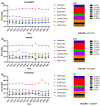Internet Health Information-Seeking Trend of Urinary Incontinence in Mainland China: Infodemiology Study
- PMID: 40549864
- PMCID: PMC12208350
- DOI: 10.2196/55670
Internet Health Information-Seeking Trend of Urinary Incontinence in Mainland China: Infodemiology Study
Abstract
Background: Urinary incontinence (UI) is a series of clinical episodes featuring involuntary urine leakage. UI affects people in terms of their physical, emotional, and cognitive functioning, and the negative perceptions and impact on patients are not fully understood. In addition, the true demand for the treatment of UI and related issues is yet to be revealed.
Objective: The aim of this study is to examine the online search trend, user demand, and encyclopedia content quality related to UI on a national and regional scale on Baidu search, the major search engine in Mainland China.
Methods: The Baidu Index was queried using UI-related terms for the period from January 2011 to August 2023. The search volume for each term was recorded to analyze the search trend and demographic distributions. For user interest, the demand graph data and trend data were collected and analyzed.
Results: Three search topics were identified with the 18 available UI search keywords. The total Baidu search index for all UI topics was 11,472,745. The annual percent changes (APCs) for the topic Complaint were 1.7% (P<.05) from 2011-2021 and -7.9% (P<.05) from 2021-2023, and the average annual percent change (AAPC) was 0.1% (P<.05). For the topic Inquiry, the APCs were 16% (P<.05) from 2011 to 2016, -27.00% from 2016 to 2019, and 21.2% (P<.05) from 2019 to 2023, with an AAPC of 4.8%. Regarding the topic of Treatment, the APC was 20.3% from 2011-2018 (P<.05), -36.9% from 2018-2021 (P>.05), and 2.2% from 2021-2023, with a -0.4% overall AAPC. The age distribution of the population of each UI search topic inquiry shows that the search inquiries for each topic were mainly made by the population aged 30 to 39 years. People from the eastern part of China made up around 30% of each search query.
Conclusions: Web-based searching for UI topics has been continuous and traceable since January 2011. Different categorized themes within the UI topic highlight specific demands from various populations, necessitating tailored responses. Although online platforms can offer answers, medical professionals' involvement is crucial to avoid misdiagnosis and delayed treatment.
Keywords: Baidu; Baidu encyclopedia; Baidu index; infodemiology; patients' concern; public interest; urinary incontinence.
© Shuangquan Lin, Lingxing Duan, Xiongbing Lu, Haichao Chao, Xi Wen, Shanzun Wei. Originally published in JMIR Formative Research (https://formative.jmir.org).
Conflict of interest statement
Figures





Similar articles
-
Conservative interventions for treating urinary incontinence in women: an Overview of Cochrane systematic reviews.Cochrane Database Syst Rev. 2022 Sep 2;9(9):CD012337. doi: 10.1002/14651858.CD012337.pub2. Cochrane Database Syst Rev. 2022. PMID: 36053030 Free PMC article.
-
Health professionals' experience of teamwork education in acute hospital settings: a systematic review of qualitative literature.JBI Database System Rev Implement Rep. 2016 Apr;14(4):96-137. doi: 10.11124/JBISRIR-2016-1843. JBI Database System Rev Implement Rep. 2016. PMID: 27532314
-
Adult women's experiences of urinary incontinence: a systematic review of qualitative evidence.JBI Database System Rev Implement Rep. 2017 May;15(5):1350-1408. doi: 10.11124/JBISRIR-2017-003389. JBI Database System Rev Implement Rep. 2017. PMID: 28498174
-
Psychological and/or educational interventions for the prevention of depression in children and adolescents.Cochrane Database Syst Rev. 2004;(1):CD003380. doi: 10.1002/14651858.CD003380.pub2. Cochrane Database Syst Rev. 2004. Update in: Cochrane Database Syst Rev. 2011 Dec 07;(12):CD003380. doi: 10.1002/14651858.CD003380.pub3. PMID: 14974014 Updated.
-
Systemic pharmacological treatments for chronic plaque psoriasis: a network meta-analysis.Cochrane Database Syst Rev. 2021 Apr 19;4(4):CD011535. doi: 10.1002/14651858.CD011535.pub4. Cochrane Database Syst Rev. 2021. Update in: Cochrane Database Syst Rev. 2022 May 23;5:CD011535. doi: 10.1002/14651858.CD011535.pub5. PMID: 33871055 Free PMC article. Updated.
References
-
- Bo K, Frawley HC, Haylen BT, et al. An International Urogynecological Association (IUGA)/International Continence Society (ICS) joint report on the terminology for the conservative and nonpharmacological management of female pelvic floor dysfunction. Int Urogynecol J. 2017 Feb;28(2):191–213. doi: 10.1007/s00192-016-3123-4. doi. Medline. - DOI - PubMed
-
- Dominguez-Antuña E, Diz JC, Ayán C, Suárez-Iglesias D, Rodríguez-Marroyo JA. Prevalence and severity of urinary incontinence among male and female competitors and recreational CrossFit practitioners. Eur J Obstet Gynecol Reprod Biol. 2022 Sep;276:144–147. doi: 10.1016/j.ejogrb.2022.07.014. doi. Medline. - DOI - PubMed
MeSH terms
LinkOut - more resources
Full Text Sources
Medical
Miscellaneous

